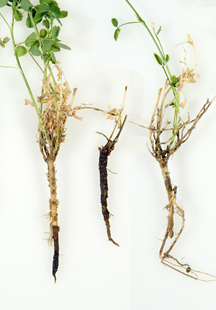Ithaca, New York
November 9, 2007
 |
|
Alfalfa roots with various degrees of brown
root rot. |
|
Cornell University plant
pathologists have detected brown root rot -- a potentially
serious forage crop disease -- in the northeastern United
States. It is widespread in New York, Vermont and New Hampshire
and has been detected in Pennsylvania and Maine.
The
findings are published in the October issue of the journal
Plant Disease.
Brown root
rot (Phoma sclerotioides) affects dairy farmers, as it attacks
forage crops alfalfa and clover.
"It's
pervasive. These were arbitrarily chosen fields, and it is
present in a majority of alfalfa fields tested in the
Northeast,"
said Gary
Bergstrom, Cornell professor of plant pathology. "At this point,
we have not identified effective controls for it," he added,
explaining that scientists are exploring disease-resistant
varieties that are adapted to the Northeast.
Brown root
rot was detected in eight of 10 fields sampled in New York
state, six of seven fields sampled in Vermont and five of six
fields sampled in New Hampshire.
The
disease's lesions begin as reddish-brown to dark brown areas of
external discoloration. As the lesions progress into the
internal plant tissues, they can take on corky texture, with a
dark border separating the healthy and diseased tissue. Lesions
that do not immediately kill the plant can vary in appearance,
making it difficult to identify the disease without laboratory
analysis.
"It was
found in a high percentage of plants in many fields, and most
lesions had advanced to the internal tissues of roots and
crowns," says Bergstrom. "This suggests that it may be a serious
factor in the health and persistence of alfalfa in the region."
Spatial
patterns within fields suggest the pathogen was not recently
introduced in the Northeast, says Michael Wunsch, Cornell
graduate student in plant pathology and the lead author of this
research. In North America, brown root rot has been a problem in
Alaska and in Alberta, Saskatchewan, Manitoba and the Yukon
Territory of Canada. In eastern North America, it had been
reported only in Nova Scotia. The disease was first observed in
the contiguous United States in 1996 in Wyoming and then
subsequently in Idaho, Montana, Minnesota and Wisconsin.
Other
authors of the study are Robert Schindelbeck, research support
specialist, and Harold van Es, professor, both of crop and soil
sciences.
New York
farmers with questions about brown root rot in their fields
should contact Cornell Cooperative Extension field crops
educators for their county. Outside of New York, farmers should
contact their local cooperative extension offices. |